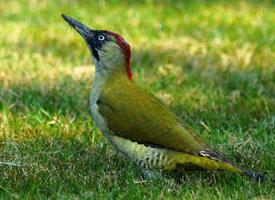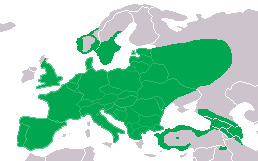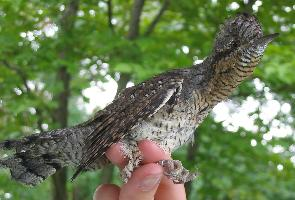
Súlyok és méretek
| Hossz | 32 cm |
|---|---|
| Súly | 185-tól 250-ig g |
| Szárnyfesztávolság | 51 cm |
Állatleírás
The European green woodpecker (Picus viridis) is a captivating bird species that is part of the woodpecker family, Picidae. Renowned for its vibrant plumage and distinctive behavior, this bird is a common sight across Europe and parts of Asia, thriving in a wide range of habitats that include deciduous forests, parklands, and even gardens. The species is notable for its striking appearance, fascinating habits, and the iconic "laughing" call that resonates through its natural habitats.Physical Description
The European green woodpecker measures approximately 30-36 cm in length, making it one of the larger species of woodpeckers found in its range. It possesses a robust body, a strong, chisel-like beak designed for pecking wood, and zygodactyl feet—two toes facing forward and two backward, which aids in gripping tree trunks and branches.
The plumage of this species is primarily a vivid green on the upper parts, blending seamlessly into the environment. The underparts are lighter, often showing a greyish or yellowish tinge. One of the most striking features of the European green woodpecker is its bright red crown, which is more pronounced in males, who also sport a red moustachial stripe. Females have a similar but usually less vibrant crown and lack the red moustachial stripe, displaying a black one instead. Both sexes have a black eye mask that contrasts sharply with their light-colored irises, adding to their distinctive appearance.
Behavior and Ecology
The European green woodpecker leads a predominantly solitary life, although pairs are formed during the breeding season. Unlike many other woodpecker species, it spends a significant amount of time foraging on the ground, primarily feeding on ants and their larvae. Its long, sticky tongue, which can extend far beyond the beak, is specially adapted for extracting insects from crevices in the bark of trees and from within ant nests.
The bird's drumming on tree trunks, a behavior common to woodpeckers, is less frequent in the European green woodpecker compared to its relatives. This is partly because it uses this behavior more for communication rather than for foraging. The species is also known for its distinctive call, often described as a loud, laughing "yaffle," which has ingrained itself into folklore and popular culture in regions where the bird is common.
Reproduction
Breeding season for the European green woodpecker begins in early spring. The birds are monogamous, with pairs forming strong bonds. They nest in cavities that are usually excavated by the male in dead or decaying trees. The female lays a clutch of 4-6 white eggs, which both parents incubate for about 14-18 days. Once hatched, the chicks are altricial, meaning they are born blind and featherless, completely dependent on their parents for food and protection. Both parents are involved in feeding the chicks, which fledge approximately 21-24 days after hatching but may remain with the parents for a period thereafter.
Conservation Status
Currently, the European green woodpecker is classified as Least Concern by the International Union for Conservation of Nature (IUCN), indicating that it is not at immediate risk of widespread decline. However, like many species, it faces threats from habitat loss and fragmentation, particularly due to the removal of dead wood from forests which impacts nesting sites and food availability. Conservation efforts aimed at preserving natural habitats and promoting biodiversity are vital to ensure the continued survival of this species and the myriad other creatures that share its ecosystem.
In summary, the European green woodpecker is a remarkable bird, both in appearance and behavior. Its vivid green plumage, distinctive calls, and unique foraging habits make it a fascinating subject for birdwatchers and nature enthusiasts. As an integral part of its ecosystem, efforts to conserve its natural habitats are crucial for the preservation of this striking species.
Előfordulási térkép

Hasonló állatok
Új állatfotók
Top 10 állat
- Dolphin gull (Leucophaeus scoresbii)
- Diana monkey (Cercopithecus diana)
- Japanese macaque (Macaca fuscata)
- Galápagos tortoise (Geochelone nigra complex)
- Stone loach (Barbatula barbatula)
- Moustached guenon (Cercopithecus cephus)
- Russian tortoise (Testudo horsfieldii)
- Common house mosquito (Culex pipiens)
- Japanese spider crab (Macrocheira kaempferi)
- Giant peacock moth (Saturnia pyri)


